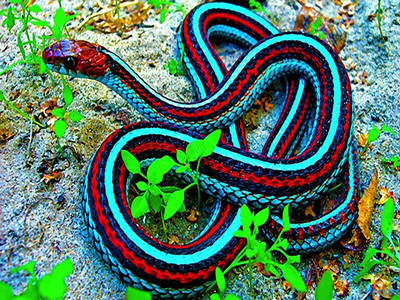(单词翻译:单击)
The Mystery Of Why Crafty Snakes Shed Their Legs Is Finally Solved
“蛇为什么没有脚”真相大白
Mention snakes and the image that comes to mind is that of a stealthily gliding reptile. Turns out that this was not always the case. Ancient snake fossils indicate that the reptiles once had legs, just like the rest of us. So why did snakes decide to shed them in favor of the slither that sends chills down our spines? That is a mystery researchers have been trying to solve for some time.
一提到蛇,大家就会想起它神出鬼没快速爬行的样子。事实证明,它并非一直如此行进。古代蛇类化石证明,它曾经和人类一样是有脚的。那为什么蛇会放弃进化它的脚,用如此让人毛骨悚然的方式爬行呢?科学家们一直在努力调查其中的奥秘。

There are currently two schools of thought. Some scientists believe that the reptiles dispensed with their legs to enable them to dwell in water. Others think that the reptiles evolved from burrowing lizards and shed their limbs over time, as they stretched and became longer.
对此,现在主要有两种假说。有些科学家认为蛇放弃进化自己的脚是为了更好的在水中生存。另一些科学家则认为蛇是由穴居蜥蜴进化而来的,它们慢慢伸展变长,逐渐放弃了自己的脚。
The first proof that the second theory is more likely came in July 2015. David Martill paleobiologist at the University of Portsmouth was leading a field trip at Germany's Museum Solnhofen when he stumbled upon a rare fossil of a four-legged snake that inhabited the planet 113-million years ago.
第二种假说的证据是在2015年7月发现的。Portsmouth大学的古生物学家David Martill在德国Solnhofen博物馆带队考察时,无意间看到了大约生活在1.13亿以前的稀有四脚蛇化石。
Now a new study conducted by a group of Scottish and American scientists further validates that snakes probably ditched their legs to slither through underground burrows, allowing them to avoid predators and pounce upon unsuspecting prey.
最近,苏格兰和美国科学家联手进行的一项新研究进一步证明了蛇也许是为更灵活的在地下洞穴穿梭,躲避捕食者突如其来的袭击,才放弃进化自己的脚。
The team led by Hongyu Yi at Edinburgh’s School of GeoSciences reached the conclusion after studying a 90 million-year-old skull of the Dinilysia patagonica an ancient reptile that is closely related to the modern-day snake. The discovery was possible thanks to new CT scan technology that allowed them to create 3D models of the skull and compare them to that of modern snakes and lizards.
爱丁堡地学院Hongyu Yi带领的团队,通过研究的一块被称为Dinilysia patagonica的古代爬行生物头骨才得出了结论。这种生物与当代蛇类有很大关联,大概存在于9亿年前。新的CT扫描技术使他们能够创建头骨的3D模型来与现代的蛇类和蜥蜴作比较,才得出此发现。
The researchers were looking to see if the reptiles shared the same unique ear structure that is found in burrowing animals. Sure enough, though the ear canals and cavities have adapted further in modern-day burrowing snakes and lizards, there remains a substantial similarity. Snakes that currently live in water or above ground do not have the same adaptations.
研究者想查眀这种爬行生物是否与穴居动物有一样的耳部结构。可以确定的是,虽然今天的穴居蛇类和蜥蜴的耳道和耳腔已有很大的改变,它们之间还是存在着某种潜在相似性。而生活在水中和陆地上的蛇类却没有这样的改变。
The evidence was enough for the scientists who published their findings in the online journal Science, to conclude that snakes had evolved on land. They believe that as the reptile's hearing sharpened and became accustomed to their subterranean habitat, its limbs began to recede, until they disappeared altogether.
此研究结果,足以让科学家在在线科学期刊上公布“曾经的水生蛇类有些进化上岸”这一发现。他们认为,爬行生物随着听觉的进化,慢慢适应陆地上的生存环境,它们的脚就也随之慢慢蜕化,直至消失。
译文属可可英语原创,仅供学习和交流使用,未经许可,请勿转载。


